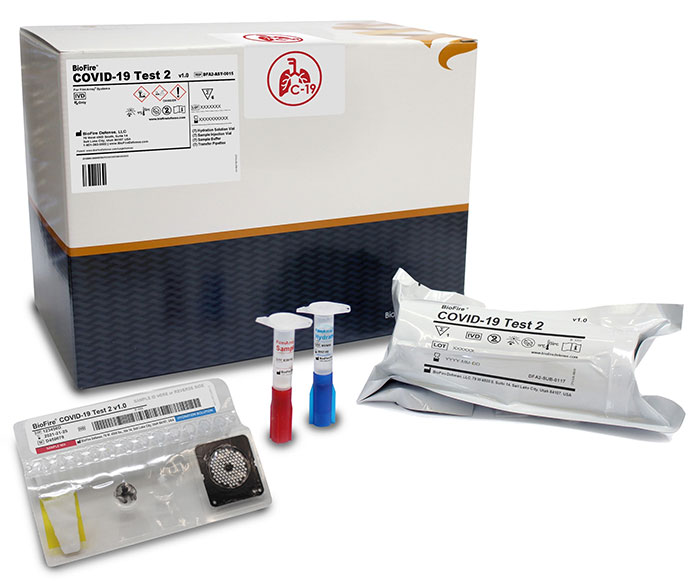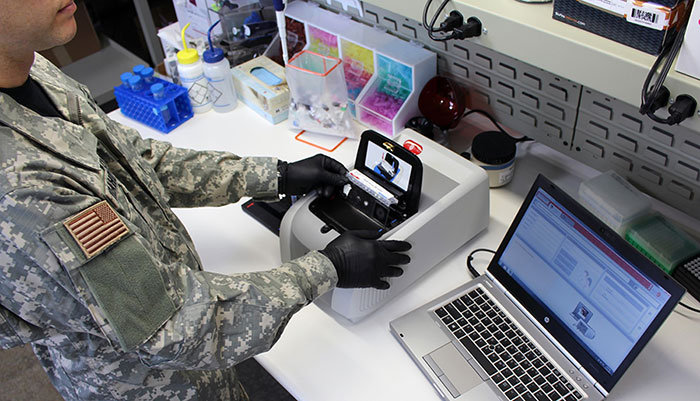USAMMDA Announces FDA 510 (k) Clearance of Rapid Diagnostic Test for COVID-19

The U.S. Army Medical Materiel Development Activity's Warfighter Protection and Acute Care Project Management Office, along with its commercial partner BioFire Defense, announced the U.S. Food and Drug Administration's 510 (k) clearance for BioFire's COVID-19 Test 2, which helps to detect the presence of SARS-CoV-2, the virus that causes COVID-19, in approximately 45 minutes.
"The BioFire COVID-19 Test 2 is an in vitro diagnostic test used in conjunction with the BioFire FilmArray instrument to analyze nasopharyngeal swab, or NPS, specimens from symptomatic individuals suspected of COVID-19 by their healthcare provider," explained Dr. Clifford Snyder, product manager and contracting officer's representative for USAMMDA's WPAC PMO.
Snyder leads the program that oversees development of the BioFire COVID-19 Test 2 for USAMMDA, which works to develop and deliver medical products to protect and preserve the lives of our nation's Service members throughout the world. These products include drugs, vaccines, biologics, devices and medical support equipment intended to maximize survival of battlefield casualties.
Recently, Snyder spoke with USAMMDA's public affairs office to discuss the COVID-19 Test 2, and its significance in the battle against the worldwide pandemic, in terms of both the nation's military and civilian populations. He said the military helps to identify infected individuals so that measures can be taken to limit the spread of disease, document infections in health records, and deliver treatments to the right people as quickly as possible.
In November 2021, the BioFire COVID-19 Test 2 received 510 (k) approval from the FDA, which means the agency has determined this test is very similar to a "predicate" device – or, one currently on the market – and can be used in similar ways, with similar controls.
"There are different pathways through which a diagnostic device manufacturer can receive marketing approval from the FDA, although the goal of each pathway is to demonstrate the device is safe and effective for use," explained Snyder. "In this case, the predicate device is the BioFire Respiratory Panel 2.1 (RP2.1), which is a panel that tests for the presence of nucleic acids from SARS-CoV-2 and 21 other pathogens that cause respiratory infections."
"Although the BioFire RP2.1 is more costly than the BioFire COVID-19 Test 2, the RP2.1 was the first FDA-approved test for use in COVID-19 diagnosis and was granted marketing approval through the "De Novo" (i.e. starting from the beginning) pathway," he continued. "Therefore, the BioFire COVID-19 Test 2 is now the second overall FDA-approved test to detect the virus."

Snyder said that in order to secure FDA clearance for its COVID-19 Test 2, USAMMDA's commercial partner performed more analytical and clinical testing than it did to qualify for the Emergency Use Authorization it received earlier for the test. Although the EUA version of the test is more versatile than the 510 (k)-cleared test, the challenge with the EUA version is that manufacturers cannot readily predict what the FDA's approach to existing EUA tests will be if and when the COVID-19 emergency is declared over. While Snyder believes the FDA will initiate a transition period prior to terminating any EUAs, he said it is not clear how long the transition period will be, or what changes might be made to qualify for clearance in the future. Now that the BioFire COVID-19 Test 2 has received 510 (k) clearance, he feels these risks have been mitigated.
Despite receiving 510 (k) approval, BioFire Defense has not yet launched Test 2 as a product available for delivery. However, the DOD has used the primary part of the test, the chemistry package, since March 2020 under the EUA, as mentioned above. Snyder said the 510(k)-cleared version of the test has been evaluated per FDA standards to demonstrate safety and effectiveness; therefore, from a regulatory perspective, it is more mature than the EUA test currently marketed as Version 1.1.
"Our colleagues at the Joint Project Manager for Chemical, Biological, Radiological and Nuclear Medical worked with BioFire Defense to develop and receive the EUA for the BioFire COVID-19 Test because the FilmArray is present in many Department of Defense medical laboratories – both deployed and in fixed facilities – and it was both feasible and desirable to introduce a COVID-19 test designed for use with that platform," said Snyder.
"The Defense Health Agency allotted Cares Act funding to USAMMDA's WPAC PMO in May 2020 to pursue two goals. The first goal was to expand the types of samples that could be used with the EUA version of the test, to provide greater flexibility to meet testing needs during the emergency. Version 1.1 does that; it can test multiple upper and lower respiratory tract sample types, including saliva, in addition to NPS specimens. The second goal was to secure FDA clearance for the testing of NPS specimens, so that the military could continue to use this test to detect SARS-CoV-2 in NPS specimens after a declared end to the emergency – that is Test 2. Both goals have now been achieved."
When asked to describe the test process, Snyder explained that a swab specimen from the nasopharynx of the patient is placed in a tube containing transport medium or saline. After transport and arrival at the testing lab, the medical technologist loads a small quantity of this fluid into the BioFire COVID-19 Test 2 pouch, and then places the pouch into the FilmArray instrument, which is connected to a computer.
"Test-specific software automates the processing of the sample within the pouch and instrument," said Snyder. "The pouch contains chemicals that will react with three specific SARS-CoV-2 nucleic acid sequences that may be present in the sample. The basis of the test is the polymerase chain reaction, which produces millions of copies of the sequence, if it is present, to make it detectable by reaction with a dye that yields light at a specific wavelength. A sensor within the FilmArray instrument detects that light, producing a signal interpreted by the software as a positive result. Within about 45 minutes after starting the run, the computer coupled to the FilmArray delivers the result, and if SARS-CoV-2 viral RNA is present in the sample, the test result will be positive."
The clinical performance of BioFire COVID-19 Test 2 was evaluated at three clinical study sites in the United States over four months (July through October 2020) during the COVID-19 global pandemic. The BioFire RP2.1 served as a comparison during the trial; its specific assays for the presence of SARS-CoV-2 differ from those in BioFire COVID-19 Test 2, though the principles of the tests are the same. This study demonstrated that the BioFire COVID-19 Test 2 is highly sensitive and specific for the presence of SARS-CoV-2 RNA/nucleic acid.
Snyder said the success of this program was made possible through a highly collaborative effort involving multiple agencies and organizations. He explained that USAMMDA's WPAC PMO provided product and project management for the BioFire COVID-19 Test 2, and business arrangements with BioFire Defense were made possible by USAMMDA's Administrative Services Division and the U.S Army Medical Research Acquisition Activity. Additionally, the USAMMDA Commander coordinated with senior leaders at U.S. Army Medical Research and Development Command Headquarters and the DHA, while the Office of Regulated Activities provided advice regarding FDA requirements in a very dynamic environment.
Snyder believes 510 (k) approval for the BioFire COVID-19 Test 2 will help both Warfighters and the civilian population by providing a cost-effective rapid testing solution that should not be compromised by any changes the FDA may make to the status of tests authorized only for emergency use. Further, he feels the BioFire COVID-19 tests, both the cleared version and the EUA version, will have continued utility in the near term, since it appears infections may continue into the foreseeable future.
"The military places great emphasis on health readiness, such that a requirement for COVID-19 testing throughout all Service branches may persist beyond the need for testing in the civilian community," said Snyder. "Our industry partner is working right now to add four additional assays to the test, to augment the three assays currently in use, in order to bolster confidence in the ability of its test to detect variants. To be clear, the current test detects omicron, the latest variant of concern."
"We were fortunate that JPM CBRN Medical had fielded the Next Generation Diagnostics System 1, the heart of which is the FilmArray, to the military services, and that many of the medical laboratories in fixed facilities had been using the FilmArray and were thus in a position to use the BioFire COVID-19 test," added Snyder. "We were especially fortunate that USAMMDA and USAMRAA had people and processes in place to allow us to respond to the pandemic even as we faced associated restrictions on our activities. I am so proud that we have outstanding team members throughout the USAMRDC who work to support our great mission of protecting the lives of our Service Members."













